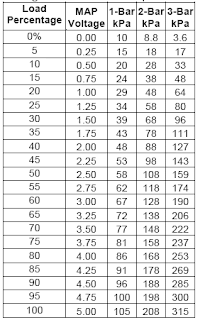Time to consider some sending units, first up will be boost, and it might as well include vacuum while I'm at it... Something affordable and widely available to noodle with seems appropriate.
This 3-bar GM-style sensor seems to cross-reference with enough other OEMs that it will fit the "available" category, and with a range from 1 bar of vacuum to 2 bar of boost, it will more than cover the 20 inches of Hg (-10 psi) to 5 psi of boost I need.
- Weatherpack connector and wiring - ground (brown), signal (orange), 5V power (yellow)
- Temperature operating range of -40 to 260 F
- Response time from 10% to 90% of range within .001 seconds
- Automatic temperature compensation
- Linear scaling at all boost and vacuum levels
- Minimum of 99% accurate over full scale
- Cross-referenced with OEM part codes as follows:
- GM: 16040749, 12223861, 12223861K
- AC DELCO: 2131562
- STANDARD MOTOR: AS210
- AIRTEX: 5S2556
- WELLS: SU504
There's quite a bit of information on the web about these sensors, as they're available from Summit Racing and other sites. There is a good cache of data at Robie the Robot specifically on the 3-bar sensor, including these data tables and drawings:
Formula for the GM 3 Bar MAP sensor is (V*8.94)-14.53, I have no idea why it's 14.53 and not 14.696, [rounds up to 14.7] but it works out on GM's chart every time. It is possible that Detroit is slightly above sea level, and you can use 12.11 in the formula for 1 mile above sea level.
This 3-bar GM-style sensor seems to cross-reference with enough other OEMs that it will fit the "available" category, and with a range from 1 bar of vacuum to 2 bar of boost, it will more than cover the 20 inches of Hg (-10 psi) to 5 psi of boost I need.
It's listed by several vendors on eBay for less than $30 with free shipping and a 2 year warranty, and according to more than one of the listings it has the following specifications:
- Weatherpack connector and wiring - ground (brown), signal (orange), 5V power (yellow)
- Temperature operating range of -40 to 260 F
- Response time from 10% to 90% of range within .001 seconds
- Automatic temperature compensation
- Linear scaling at all boost and vacuum levels
- Minimum of 99% accurate over full scale
- Cross-referenced with OEM part codes as follows:
- GM: 16040749, 12223861, 12223861K
- AC DELCO: 2131562
- STANDARD MOTOR: AS210
- AIRTEX: 5S2556
- WELLS: SU504
There's quite a bit of information on the web about these sensors, as they're available from Summit Racing and other sites. There is a good cache of data at Robie the Robot specifically on the 3-bar sensor, including these data tables and drawings:
Formula for the GM 3 Bar MAP sensor is (V*8.94)-14.53, I have no idea why it's 14.53 and not 14.696, [rounds up to 14.7] but it works out on GM's chart every time. It is possible that Detroit is slightly above sea level, and you can use 12.11 in the formula for 1 mile above sea level.
A good full-size shot of this Delphi drawing and specs is available here.




































